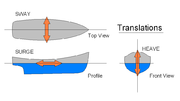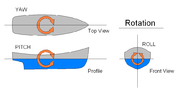
Ship motions
Encyclopedia
Ship motions are defined by the six degrees of freedom that a ship, boat or any other craft
can experience.
 Heave
Heave
Sway
Surge
Yaw axis is a vertical axis through an aircraft
, rocket
, or similar body, about which the body yaws; it may be a body, wind, or stability axis. Also known as yawing axis.
The yaw axis is defined to be perpendicular
to the body of the wings with its origin at the center of gravity and directed towards the bottom of the aircraft. A yaw motion is a movement of the nose of the aircraft from side to side. The pitch axis is perpendicular to the yaw axis and is parallel to the body of the wings with its origin at the center of gravity
and directed towards the right wing tip. A pitch motion is an up or down movement of the nose of the aircraft. The roll axis is perpendicular to the other two axes with its origin at the center of gravity.
The lateral axis passes through the plane from side to side. Rotation about this axis is called pitch. Pitch changes the vertical direction the aircraft's nose is pointing. The elevators are the primary control of pitch. Also called Transverse axis.
.
The longitudinal axis passes through the plane from nose to tail. Rotation about this axis is called bank or roll. Bank changes the orientation of the aircraft's wings with respect to the downward force of gravity. The pilot changes bank angle by increasing the lift on one wing and decreasing it on the other. This differential lift causes bank rotation around the longitudinal axis. The ailerons are the primary control of bank. The rudder also has a secondary effect on bank.
 There are three special axes in any ship, called vertical, lateral and longitudinal axes. The movements around them are known as roll, pitch and yaw.
There are three special axes in any ship, called vertical, lateral and longitudinal axes. The movements around them are known as roll, pitch and yaw.
Roll
Pitch
Yaw
s and bilge keel
s, or active mechanical devices like counterweights, anti-roll tanks, and stabilizing fins
.
Craft (vehicle)
The word craft since the 17th century has denoted a vehicle or vessel that is used for transportation on the sea, in the air or in space. But it can be applied to fictional vessels such as time craft, dimensional craft, and probability craft...
can experience.
Translation

- is the linearLinearIn mathematics, a linear map or function f is a function which satisfies the following two properties:* Additivity : f = f + f...
vertical (up/down) motion
Sway
- is the linear lateral (side-to-side) motion
Surge
- is the linear longitudinalLongitudinalLongitudinal may refer to:* Longitudinal engine, an internal combustion engine in which the crankshaft is oriented along the long axis of the vehicle, front to back...
(front/back) motion
Vertical axis
Vertical axis, or yaw axis — an axis drawn from top to bottom, and perpendicular to the other two axes. Parallel to the fuselage station.Yaw axis is a vertical axis through an aircraft
Aircraft
An aircraft is a vehicle that is able to fly by gaining support from the air, or, in general, the atmosphere of a planet. An aircraft counters the force of gravity by using either static lift or by using the dynamic lift of an airfoil, or in a few cases the downward thrust from jet engines.Although...
, rocket
Rocket
A rocket is a missile, spacecraft, aircraft or other vehicle which obtains thrust from a rocket engine. In all rockets, the exhaust is formed entirely from propellants carried within the rocket before use. Rocket engines work by action and reaction...
, or similar body, about which the body yaws; it may be a body, wind, or stability axis. Also known as yawing axis.
The yaw axis is defined to be perpendicular
Perpendicular
In geometry, two lines or planes are considered perpendicular to each other if they form congruent adjacent angles . The term may be used as a noun or adjective...
to the body of the wings with its origin at the center of gravity and directed towards the bottom of the aircraft. A yaw motion is a movement of the nose of the aircraft from side to side. The pitch axis is perpendicular to the yaw axis and is parallel to the body of the wings with its origin at the center of gravity
Center of gravity
In physics, a center of gravity of a material body is a point that may be used for a summary description of gravitational interactions. In a uniform gravitational field, the center of mass serves as the center of gravity...
and directed towards the right wing tip. A pitch motion is an up or down movement of the nose of the aircraft. The roll axis is perpendicular to the other two axes with its origin at the center of gravity.
Lateral axis
Lateral axis, transverse axis, or pitch axis — an axis running from the pilot's left to rightThe lateral axis passes through the plane from side to side. Rotation about this axis is called pitch. Pitch changes the vertical direction the aircraft's nose is pointing. The elevators are the primary control of pitch. Also called Transverse axis.
Longitudinal axis
Longitudinal axis, or roll axis — an axis drawn through the body of the vehicle from tail to nose in the normal direction of movement, or the direction the pilot faces. Parallel to the waterlineWaterline
The term "waterline" generally refers to the line where the hull of a ship meets the water surface. It is also the name of a special marking, also known as the national Load Line or Plimsoll Line, to be positioned amidships, that indicates the draft of the ship and the legal limit to which a ship...
.
The longitudinal axis passes through the plane from nose to tail. Rotation about this axis is called bank or roll. Bank changes the orientation of the aircraft's wings with respect to the downward force of gravity. The pilot changes bank angle by increasing the lift on one wing and decreasing it on the other. This differential lift causes bank rotation around the longitudinal axis. The ailerons are the primary control of bank. The rudder also has a secondary effect on bank.
Rotation motions

Roll
- is when the vessel rotates about the longitudinal (front/back) axis
Pitch
- is when the vessel rotates about the transverse (side-to-side) axis
Yaw
- is when the vessel rotates about the vertical (up-down) axis
Stabilization
There are methods for both passive and active motion stabilization used in some designs. They can include static hull features such as skegSkeg
A skeg is a sternward extension of the keel of boats and ships which have a rudder mounted on the centre line. The term also applies to the lowest point on an outboard motor or the outdrive of an inboard/outboard...
s and bilge keel
Bilge keel
A bilge keel is used to reduce the hull's tendency to roll. Bilge keels are employed in pairs . A ship may have more than one bilge keel per side, but this is rare. Bilge keels increase hydrodynamic resistance to rolling, making the ship roll less...
s, or active mechanical devices like counterweights, anti-roll tanks, and stabilizing fins
Stabilizer (ship)
Ship stabilizers are fins mounted beneath the waterline and emerging laterally. In contemporary vessels, they may be gyroscopically controlled active fins, which have the capacity to change their angle of attack to counteract roll caused by wind or waves acting on the ship.The bilge keel is an...
.
See also
- translation (physics)Translation (physics)In physics, translation is movement that changes the position of an object, as opposed to rotation. For example, according to Whittaker:...
- rotationRotationA rotation is a circular movement of an object around a center of rotation. A three-dimensional object rotates always around an imaginary line called a rotation axis. If the axis is within the body, and passes through its center of mass the body is said to rotate upon itself, or spin. A rotation...
- Naval architectureNaval architectureNaval architecture is an engineering discipline dealing with the design, construction, maintenance and operation of marine vessels and structures. Naval architecture involves basic and applied research, design, development, design evaluation and calculations during all stages of the life of a...
- SeakeepingSeakeepingSeakeeping ability is a measure of how well-suited a watercraft is to conditions when underway. A ship or boat which has good seakeeping ability is said to be very seaworthy and is able to operate effectively even in high sea states....
- Stern suction
- Ship stabilityShip stabilityShip stability is an area of naval architecture and ship design that deals with how a ship behaves at sea, both in still water and in waves. Stability calculations focus on the center of gravity and center of buoyancy of vessels and on how these interact....
- Ship motion testShip motion test-Straight line test:The velocity-dependent derivatives Yv and Nv of the ship at any draft and trim can be determined from the model test carried in towing tank. The model is towed with a constant velocity corresponding to a given ship Froude number at various angles of attack, β. A dynamometer at...
- Flight dynamicsFlight dynamicsFlight dynamics is the science of air vehicle orientation and control in three dimensions. The three critical flight dynamics parameters are the angles of rotation in three dimensions about the vehicle's center of mass, known as pitch, roll and yaw .Aerospace engineers develop control systems for...

